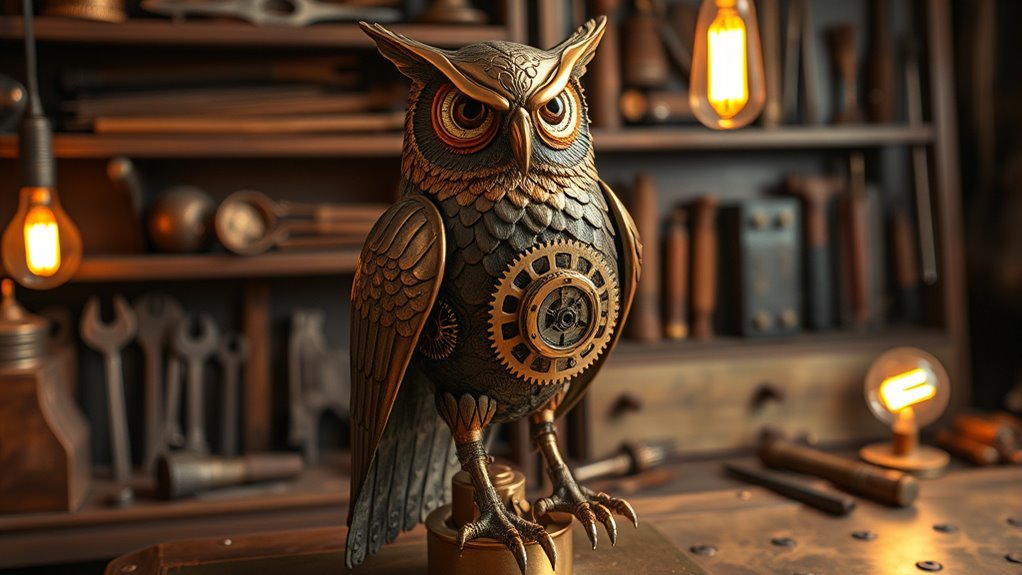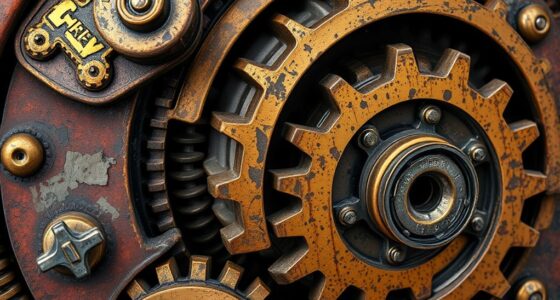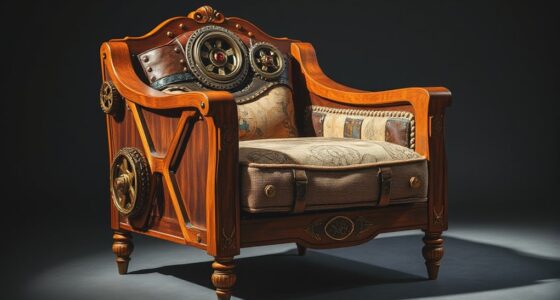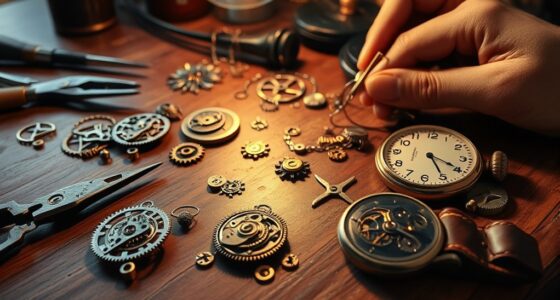To build steampunk automata at home, you’ll need to master gear mechanisms that transfer force smoothly and precisely. Incorporate Victorian-inspired details like brass fittings and ornate dials for authentic aesthetics. Integrate steam power with miniature boilers or pressurized chambers, ensuring safe flow control. Carefully assemble your metal or wood frame, aligning gears and joints for seamless movement. If you keep exploring, you’ll discover how to bring your clockwork creatures to life with enchanting Victorian charm.
Key Takeaways
- Use precise gear mechanisms and proper alignment to ensure smooth, reliable movements in your automaton.
- Incorporate Victorian-inspired aesthetic details like brass fittings and ornate dials for authentic steampunk style.
- Integrate small steam power components carefully, controlling steam flow for dynamic, lifelike motions.
- Construct a sturdy mechanical frame from metal or wood, testing gear operation manually before adding steam power.
- Focus on accurate assembly and troubleshooting early to prevent mechanical issues and achieve seamless clockwork movement.

Building steampunk automata combines creativity with craftsmanship, allowing you to bring Victorian-inspired mechanical figures to life. To start, you’ll want to understand the core principles behind gear mechanisms, which are fundamental to creating movement and life in your automaton. Gear mechanisms transfer force efficiently, enabling your automaton to perform intricate motions, from simple arm swings to complex rotations. Selecting the right gear ratios is essential; it determines the speed and torque of each movement, giving your automaton a smooth, realistic operation. As you assemble the gears, pay close attention to precision—misaligned teeth can cause jams or erratic behavior, ruining the illusion of a seamless, mechanical creature.
Next, the concept of steam power plays a pivotal role in authentic steampunk automata. While many hobbyists opt for clockwork springs, incorporating steam power adds a dramatic, vintage touch that elevates your project. You don’t need a full-scale boiler; small, pressurized chambers or miniature steam engines can generate enough force to animate your automaton. The key is controlling the steam flow carefully, using valves and regulators to verify safe operation. When you harness steam power, your automaton’s movements feel more dynamic and alive, echoing the grandeur of Victorian engineering. It’s also satisfying to see your creation operate on a power source that’s both impressive and historically evocative.
Constructing your automaton involves designing a sturdy frame that accommodates all mechanical parts. You’ll want to craft or source metal or wood components that support the gear mechanisms and steam components securely. Attention to detail is essential—each joint, axle, and gear must fit precisely to avoid unnecessary friction or slippage. You may find that customizing parts or machining your own components yields better results than relying solely on off-the-shelf pieces. Once assembled, test your gear mechanisms by manually turning the gears before introducing steam power. This step helps identify any misalignments or mechanical issues early, saving you time during final testing.
Finally, adding Victorian-inspired embellishments completes the aesthetic. Brass fittings, ornate dials, and decorative rivets give your automaton its authentic steampunk look. When everything comes together—gear mechanisms turning smoothly, steam power providing force, and artistic details adding character—you’ll have created a captivating, clockwork creature. Building steampunk automata is a rewarding process that challenges your technical skills and sparks your imagination. With patience and precision, you’ll craft a mechanical marvel that embodies the spirit of Victorian invention and steampunk fantasy. Understanding gear mechanisms and their importance is crucial for building functional automata.
Frequently Asked Questions
What Safety Precautions Are Recommended for Beginners?
When starting to build steampunk automata, safety precautions are essential. You should always wear safety gear like goggles and gloves to protect your eyes and hands. Make certain your workshop has proper ventilation to avoid inhaling fumes from glue or metalwork. Keep your workspace organized to prevent accidents, and work slowly and carefully. Following these safety tips helps you enjoy your project while minimizing risks, making your creative process safe and fun.
How Long Does It Typically Take to Complete a Project?
When you wonder how long a project takes, it depends on your skill development and your project planning. Beginners often need extra time to learn new techniques, so expect at least a few weeks for simple automata. More complex creations might take months. Stay patient, break the project into steps, and enjoy the process. Your skill will improve with time, making future projects faster and more rewarding.
Are There Specific Tools Required for Advanced Automata?
Are there specific tools required for advanced automata? Absolutely. Precision tools are essential to guarantee detailed assembly and flawless movement. You’ll need fine-tipped screwdrivers, tweezers, and magnifying glasses for intricate work. Mastering advanced assembly techniques also demands specialized tools like mini pliers and soldering kits. These tools help you achieve precise, durable results, making your automata not only impressive but also reliable, whether you’re fine-tuning gears or assembling delicate components.
Can Automata Be Customized for Different Themes?
Yes, automata can definitely be customized for different themes. You can incorporate themed embellishments and use various customization techniques to match your desired style. Whether you want a whimsical, futuristic, or traditional look, you can add unique details like painted accents, different gears, or decorative elements. This allows you to personalize your automaton, making it a true reflection of your creativity and preferred theme.
Where Can I Find Authentic Steampunk-Inspired Materials?
Imagine stepping into a bustling bazaar of forgotten treasures, where vintage hardware and industrial supplies whisper stories of a bygone era. You can find authentic steampunk-inspired materials at antique shops, flea markets, or specialty online stores. Look for brass gears, cogs, and aged metal parts that evoke industrial charm. Craft stores and salvage yards also offer unique pieces, helping you bring your steampunk automata to life with genuine, antique flair.
Conclusion
So, now that you’ve dived into designing and developing delightful, daring, and detailed steampunk automata, remember that patience, precision, and passion are your best tools. With every gear, gadget, and gesture, you craft more than just machines—you create masterpieces of imagination and ingenuity. Keep experimenting, keep evolving, and let your love for levers and latches lead you to limitless levels of craftsmanship. Your steampunk story is only just beginning—so step up, stay inspired, and let your automata amaze!









